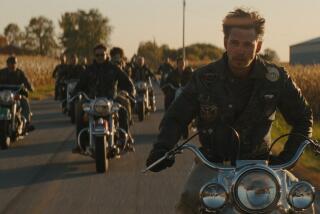‘Gerry’ goes where few dare to tread
There are about five people who are going to dig Gus Van Sant’s new film -- and, yeah, well, I’m one of them. A tough, vigorous exercise in cinematic form and pure aesthetics, “Gerry” is about two guys, played by Matt Damon and Casey Affleck, who embark on a wilderness hike in an unidentified desert and promptly lose the trail. For most of the film’s 103-minute running time, the two just walk and walk some more; every so often, they sit on the ground and pant. During a moment of despair, one man starts to cry. During another, one attacks the other, trying to choke out the breath that the desert hasn’t already stolen.
Although eventually it emerges that there’s something of a story -- the travelers go astray like Hansel and Gretel, though their fate hews closer to that of the Donner party -- “Gerry” is about as non-narrative a film as you’re likely to see in commercial theaters. This makes it a curiosity and, less charitably, something of a gimmick, but mostly it makes it a challenge. Non-narrative films require patience, and patience isn’t often required of us at the movies, where we expect our stories to move as fast as an eye blink. Even as carefully packaged “reality” dribbles ceaselessly out of the television tap, what’s gone missing from many American movies is a sense of duration, of time passing as it does in everyday life, in long, uninterrupted stretches of nothing rather than rapidly alternating shards of story.
*
When the story recedes
Despite this accelerated pace our movies remain enslaved to three-act narratives, with nearly every element -- the editing, music and performances -- marshaled to advance what happens and why. When the story recedes in a movie as dramatically as it does in “Gerry,” we tend to either make a dash for the exit or start searching for something else to grasp; we flail for a lifeline to meaning. In this case we needn’t look far, because Van Sant has given us plenty to hold onto. Whether it’s the overwhelming beauty of the landscape, the worry that flutters across Affleck’s delicate features, or the determination that sets Damon’s face into a mask as impervious as the surrounding stone, meaning is continuously seeping out of these images. (Here, form is content -- or maybe it’s the other way around.)
One of the striking things about “Gerry” is that it underscores the fact that we’re rarely asked to really look at a movie, to pay attention to the way shadows swallow light and to the swirls of the celluoid grain. In much the same way that the movie reveals a world we may not have previously seen, it also broadcasts noises that often remain in the background. In a movie that is never actually silent, just quiet, we are invited to listen to birds screech, to insects whir and to the faint echo of thunder (forecasting rain that never falls) as closely as we would any conversation. When the men do talk, it’s almost a shock; it’s a rude interruption of this natural orchestration, made all the ruder by the fact that the two characters sound like errant second cousins of Jeff Spicoli, the stoned surfer from “Fast Times at Ridgemont High.”
Much of the pair’s conversation sounds incidental, at times absurdly comical -- “Gerry” is an all-purpose word for screwing up -- but like a close-up image of the two walking, in which their heads bob in synchrony before shifting to a contrapuntal rhythm, there’s consistently more here than meets the eye (or ear). Not much happens in the obvious sense, but this is the first film I’ve seen in a while that made me think about how, in the face of their own mortality, human beings have a way of invariably pinning the blame on someone else. More brutally, it also reminded me that there are times when all it takes to divide the weak from the strong, the victim from his victimizer, are a couple of tears.
Shot on celluloid by Harris Savides, “Gerry” reconfirms a gift for landscape that was critical to Van Sant’s earlier features. The changes in texture and color as the men walk across tawny desert scrub to rocky hills and finally across bleached-white salt flats are pictorially beautiful but do their share of explaining too, since by the time the pair stagger over the white plain they’re as parched as the landscape. Throughout, the camera prowls alongside the travelers, only to periodically abandon them and sweep across the sky. In Van Sant’s “My Own Private Idaho,” the repeated images of rapidly scudding clouds represented the narcoleptic dreams of the character played by River Phoenix. Here, though, the sky is more threatening, as unforgiving and unyielding as the land.
*
Van Sant’s inspiration
Van Sant claims that part of what inspired him to make “Gerry” is the work of Bela Tarr, a Hungarian director most celebrated for his 1994 seven-hour epic film, “Satantango.” Pushing real time to levels rarely seen in movies since Andy Warhol trained his camera on the Empire State Building, Tarr makes features filled with long, uninterrupted takes that seem, almost mystically, to close the divide between you and the screen. Of his work, he once said, “My films don’t simply tell a story, they relate the world that surrounds it.” Like those paintings in which you can see the artist’s gestures across the canvas, these are films that bring you to the moment of creation, as in the first 11 minutes or so of “Satantango,” when some cows move through a muddy field ... very, very slowly.
Admittedly, one person’s aesthetic bliss-out is another person’s raging bore; put another way, Tarr’s films exemplify the sort of extreme cinema that separates the wimps from the true believers. “Gerry” isn’t as rigorous or demanding as Tarr’s work, but it’s a safe bet that it will have more detractors than admirers. That’s understandable, but it’s too bad that the film has ended up requiring a hard sell. There are all sorts of reasons to love movies, and formal experimentation seems like one of the least shameful. “Gerry” never reaches the sublime heights of “Satantango,” but it isn’t because it’s boring. Rather, like Van Sant’s much-derided remake of “Psycho,” it doesn’t carry much metaphysical heft; it’s an exercise, not an epiphany.
Bela Tarr may have inspired “Gerry,” but a more instructive influence is Erich von Stroheim’s 1925 “Greed,” from which Van Sant lifts a symbolic scene. Like Orson Welles’ “The Magnificent Ambersons,” Von Stroheim’s butchered masterpiece is perceived as a symbol of the film industry’s rapacious disregard for its artists, at once a tragedy and a cautionary tale. Over the last decade, Van Sant reaped great commercial success with features such as “Good Will Hunting,” movies that made him famous and no doubt wealthy but that have taken him far afield from his art-school roots. If nothing else, “Gerry” marks a genuine attempt by Van Sant to reclaim a personal voice that had gone mute, to rediscover, as it were, his own private Idaho. With “Gerry,” it only looks like he’s lost.
*
‘Gerry’
MPAA rating: R, for language
Times guidelines: Some crude language and one scene of violence
Matt Damon
Casey Affleck
A My Cactus Inc. presentation, released by ThinkFilm. Director Gus Van Sant. Writers Gus Van Sant, Casey Affleck, Matt Damon. Producer Dany Wolf. Director of photography Harris Savides. Steadicam Jen Wall. Music Arvo Part. Running time: 1 hour, 43 minutes.
Exclusively at Landmark’s Nuart Theater, 11272 Santa Monica Blvd., (310) 478-6379.
More to Read
Only good movies
Get the Indie Focus newsletter, Mark Olsen's weekly guide to the world of cinema.
You may occasionally receive promotional content from the Los Angeles Times.










